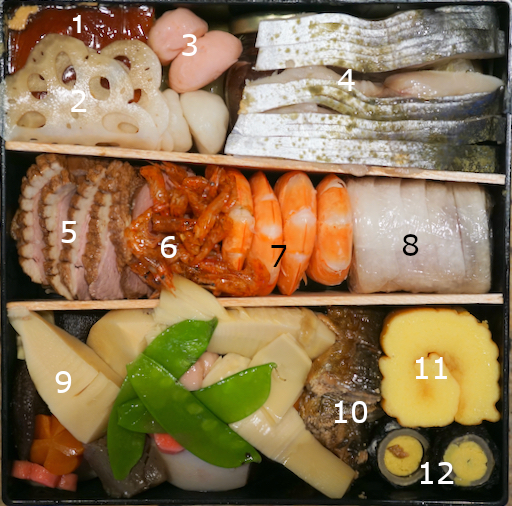Before we started getting
Sushi Taro's New Year's osechi box, I used to make a three tier osechi box myself. I filled the bottom layer with simmered vegetables and chicken dish called chikuzen-ni 筑前煮. The type of potato used in that dish is sato-imo
里芋 which was always available in
my old Japanese grocery store. I see sato-imo at our new Japanese grocery store very rarely. The other day, when I was in our regular grocery store, I saw sato-imo which was labeled as "
Malanga" and "
Eddoe" (its scientific name
Colocasia esculenta) from Costa Rica (#1 in the composite picture below).
Taro is slightly different but the most common variety in the US. Common among these variations is that it is taste like potato but it is a thickened underground stem called
corms. I am sure different cultures have different cultivars and names other than those I just mentioned but whatever the name, they appear to be essentially similar in texture and taste. Even in Japan, there is another variation of sato-imo called ebi-imo
海老芋 , ("ebi" means shrimp. It is long and curved resembling the tail of a shrimp). This is famous for its use in traditional Kyoto cuisine 京料理. Actually, the one I got this time is more similar in shape to ebi-imo than Japanese sato-imo.
I made this classic New Year simmered vegetable dish. This time, I did not include any protein such as chicken.
I also added bamboo shoots or takenoko 竹の子, kon-nyaku こんにゃく, carrot and garnished with blanched snap peas or sugar snaps.
Ingredients: (for 10 small servings like shown in pictures above).
Taro (sato-imo): 10 (see directions below for preparation).
Bamboo shoot: one package, previously boiled and packed in a plastic pouch, cut into 4 pieces lengthwise, then the bottom thick portions cut into half inch thick cross pieces and the top cut lengthwise.
Kon-nyaku (Konjac): 1 cake, hand torn into small bite sized pieces and par-boiled and drained (#5).
Carrots: 2-3 large, peeled and cut in bite size ("
Ran-giri" 乱切, cut on the bias as you turn 90 degree).
Bonito and kelp broth (3-400ml, enough to cover the vegetables).
Sake
Mirin
Soy sauce (I used light colored soy sauce or "Usukuchi" 薄口醤油).
Sugar snap peas: ends trimmed, blanched, for garnish
Directions:
The classic Japanese satoimo is usually shorter than the one I got this time. This "Malanga" or "Eddoe" from Costa Rica (#1 in picture below) may more closely resemble "Ebi-imo"
海老芋. If this is more uniform rounder Japanese sato-imo, you could remove the skin by rubbing against each other in water which makes a nice rounded shape but I removed the skin by cutting off the top and the bottom and making hexagonal cylindrical shapes (making 6 faceted cylinders, a bit similar to making "tourne"). This is called "Roppou-muki"
六方むき meaning six facet peeling in Japanese culinary parlance (#2, I now realized this one only has 5 facets!).
I soaked them in cold water and washed them changing the water few times (#3).
I made broth from a dashi pack (bonito and kelp), seasoned with sake, mirin and light colored soy sauce (#4). Some may add sugar and the amount of soy sauce could be variable depending on your preference. I made it more Kyoto style or "usu kuchi" meaning mildly seasoned. I added soy sauce in several increment as I tasted.
I placed the satoimo in the broth (#4) when it started simmering I added the carrot, bamboo shoot and kon-nyaku (#5 and #6). I let it gently simmer with a lid on for 30 minutes or until sato-imo is cooked.
This is a very subtle dish but has so many different textures. Sato-imo has very unique texture (creamy slightly viscous), which is difficult to describe. The small serving in the picture is perfect for a drinking snack for us. For a side dish eaten with rice, I will served at least twice as much and probably add more soy sauce and/or salt.





























